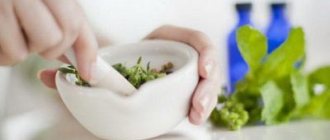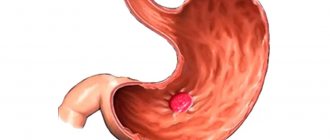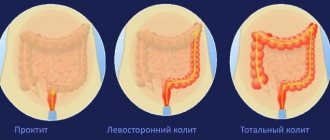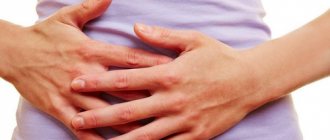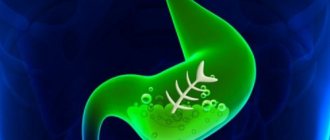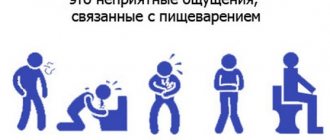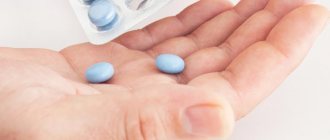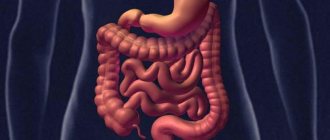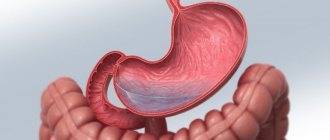Gastroduodenitis is an inflammation of the gastric mucosa that spreads to the mucous membranes of the duodenum. In this case, the duodenum suffers from a secondary process at the moment when inflammation passes to it from the gastric mucosa.
Gastroduodenitis belongs to the category of chronic gastritis due to secondary involvement of the duodenum. The risk group mostly includes children and young people, because by mature and middle age the peculiarity of the functioning of the valve between the stomach and duodenum disappears.
The main causes of gastroduodenitis lie in poor diet, stress and genetic predisposition. Side factors in the development of the disease are Helicobacter bacteria, smoking, chronic tonsillitis, caries, intestinal infections and diseases of the liver, pancreas or gall bladder.
In the presence of an underlying disease, gastroduodenitis has the nature of a secondary disease. If the development of pathology occurs on its own, it is primary.
Symptoms and signs
The primary signs of gastroduodenitis are pain. Acute gastroduodenitis is manifested by the following symptoms:
- feeling of heaviness;
- acute pain in the navel and pit of the stomach;
- nausea and vomiting;
- belching of air or sour liquid contents;
- dizziness;
- severe heartburn.
Symptoms of gastroduodenitis appear over a short period of time, but are very pronounced. In this case, the secondary form often has signs of the underlying disease to a greater extent.
The acute form of the pathology has a cyclical nature of the appearance of symptoms. The severity of the symptoms depends on:
- depth and area of inflammation;
- acidity level;
- general condition of the body.
Chronic gastroduodenitis has the following symptoms:
- overcrowding and heaviness in the epigastric region;
- aching pain on a constant basis before eating and a couple of hours after;
- heartburn before eating;
- pain is accompanied by nausea;
- mild pain during palpation;
- white coating on the tongue, bitterness or metallic taste in the mouth;
- irritability, fatigue, insomnia, weight loss with the same level of appetite;
- constipation with high acidity levels;
- frequent changes in constipation and diarrhea with reduced secretion.
During exacerbations, these symptoms become pronounced. Intense pain is often accompanied by nausea and vomiting, heartburn.
Do you have symptoms of gastroduodenitis?
Only a doctor can accurately diagnose the disease. Don't delay your consultation - call
How to treat chronic gastroduodenitis?
In case of chronic gastroduodenitis, first of all it is necessary to follow a diet. With high acidity, you should focus on table No. 1B of the Pevzner diet, with low acidity - on table No. 2.
You will have to give up pickles, smoked foods, preservatives, spicy foods, fatty and fried foods.
You should follow a split diet, eat in small portions, and avoid foods that irritate the mucous membrane of the digestive organs.
Additional recommendations:
- in case of high acidity, absolutely all fruits, dairy products - except milk, tea and cocoa - should be excluded from the diet;
- if it is low, it is advisable to include citrus fruits, cocoa with milk, and tomato juice in the daily menu.
The purpose of therapeutic nutrition is to normalize secretory function.
Therapeutic treatment regimen
Treatment of chronic gastroduodenitis during exacerbation takes place in several stages.
Be sure to prescribe medications to reduce acidity or stabilize it. In the first case, “Omez”, “Lansoprazole”, “Lanza”, “Omeprozole” are used; in the second - hydrochloric acid inhibitors.
To reduce irritation of the walls of the digestive organs, antacids are used - “Phosphalugel”, “Almagel”.
If during an exacerbation an upset stomach begins, enterosorbents with an enveloping effect are used - “Polysorb”, “Smecta”. These drugs are prescribed in cases where the cause of the disease is intoxication.
H2-histamine receptor blockers are also used - Cimetidine, Famotidine.
In the case when Helicobacter Pylori is detected, treatment is supplemented with antimicrobial therapy. Patients are prescribed a complex that includes two groups of drugs: antiprotozoal, with the active ingredient metronidazole, and tetracycline antibiotics.
During an exacerbation, it is advisable to adhere to bed rest and take food only in pureed form. It is advisable to follow the diet after an exacerbation for 1-2 months, but grinding foods is no longer required.
Treatment of chronic gastroduodenitis can be supplemented with antispasmodics, antioxidants, immune drugs, and sedatives. Drug treatment is adjusted depending on the clinical picture. Patients are often prescribed injections of B vitamins and reparants (medicines that accelerate mucosal regeneration).
Causes of occurrence and development
All causes of gastroduodenitis can be divided into several groups:
- endogenous or internal - lack of mucus production, high acid production, disturbances in hormonal secretion, genetic predisposition, chronic diseases of the oral cavity and pharynx, for example, caries or inflammation of the tonsils, as well as the liver and biliary tract;
- exogenous or external - irregular diet, alcohol abuse, psychological factors, for example, stress and overload, abuse of hot or cold, fatty and spicy, rough foods, prolonged use of non-steroidal anti-inflammatory or antibacterial drugs, infection with the bacterium Helicobacter pylori.
In practice, the disease develops and progresses under the influence of several factors simultaneously.
Causes of the disease
There are 10 main causes of superficial gastritis duodenitis. These include:
- Poor nutrition. Irregular meals, eating on the go, dry snacks and fast food. The reason may be the presence of multiple spicy, fatty and heavy foods in the human diet. Pickled foods and smoked foods are also very dangerous for the stomach and duodenum.
- Lifestyle. Bad habits, smoking and drinking alcohol inevitably lead to problems with the gastrointestinal tract.
- Stress. Depressive states, psychological tension and stressful conditions negatively affect the functioning of the gastrointestinal tract.
- Chemicals. The action of chemicals is especially dangerous when working in production.
- Drugs. Long-term use of certain drugs can adversely affect health and damage the mucous membranes and duodenum. Long-term use of nonsteroidal and steroidal drugs is especially harmful.
- Pathologies. Especially pathologies of the liver and biliary tract.
- Bacterial factors. Impact of Helicobacter.
- Penetrating radiation.
- Predisposition and heredity.
- Allergic reactions.
These are the main, most common causes of superficial gastritis duodenitis. The superficial type of illness is the beginning of the development of a full-fledged illness.
Classification
There are a number of signs for identifying types of gastroduodenitis - the severity of the inflammatory process and the level of acidity.
Depending on the severity of inflammation, it can be:
- superficial gastroduodenitis - an acute form with swelling and thickening of the folds of the membrane;
- hypertrophic gastroduodenitis - redness and white plaque, as well as hemorrhages with small dots;
- mixed gastroduodenitis - a hypertrophic form with the addition of atrophy of the mucous membranes;
- erosive gastroduodenitis - a large number of erosive spots or ulcers on the surface in the form of a film or plaque, is the last stage before the ulcer.
Based on acidity level, they are divided into:
- increased acidity is accompanied by increased gastric secretion - the most common;
- normal secretion;
- decreased secretion accompanies malignant neoplasms of the stomach.
There are a number of atypical forms of gastroduodenitis, which are characterized by the absence of symptoms.
What is erosive gastroduodenitis
Pathology can develop over a long time, or occurs suddenly.
Need to know!
The word “gastroduodenitis” itself means inflammation of the stomach and duodenum.
Erosive gastroduodenitis is a condition when, against the background of inflammatory disorders of the mucous membrane of the stomach and duodenal bulb, surface defects are formed.
Erosive gastroduodenitis
The diagnosis is confirmed if morphological changes are visualized. Foci in the form of separate areas of erosion with a perifocal zone of edema are visible on the mucosa. There may be multiple or single erosive elements. There are different variants of the prevalence of tissue inflammation - with manifestations of gastritis, bulbitis, reflux esophagitis.
Classification
Specialists differentiate the disease, which allows for a more detailed diagnosis. This is necessary to choose the right approach to diagnosis and treatment. The working classification reflects a number of criteria that are taken into account when forming a clinical diagnosis. Variants of erosive gastroduodenitis are reflected in the table.
Table 1. Classification
| Criteria | Kinds |
| Type of occurrence | Primary Secondary |
| Stage | Exacerbation Remission:
|
| Development option | Malignant Benign |
| Number of lesions | With single defects - up to three elements; With multiple defects - four or more |
| Form | Acute Chronic |
| According to the degree of maturity of erosions | Immature - young lesions; Mature - with foci of necrotization |
| Histological type | Erosive-hemorrhagic Erosive-ulcerative Surface |
Diagnostics
If there are symptoms of gastroduodenitis, the gastroenterologist conducts additional diagnostics.
If erosive gastroduodenitis is suspected, it is necessary to find out the patient’s complaints, medical history and evaluate objective data. Then instrumental methods are prescribed, which are presented:
- Study of general and biochemical blood parameters.
- Analysis of stool to identify blood cells.
- Tests for determining the bacterium Helicobacter pylori - respiratory urease, serological markers, PCR.
- Fibrogastroduodenoscopy (FGDS) with taking histological samples.
- X-ray examination using a barium suspension.
- Ultrasound examination - to exclude disorders of parenchymal organs.
Complications
The most important negative consequence is the transition of gastroduodenitis to gastric and duodenal ulcers. As a result of these diseases, the risk of bleeding and gastric perforation increases. In addition, damaged mucous membrane becomes a favorable environment for the development of stomach cancer.
When to see a doctor
If you suspect the development of gastroduodenitis or the appearance of primary symptoms, you should contact a gastroenterologist for help. After all, an advanced form of pathology brings enormous discomfort and limits the activity of normal life. At the same time, the risk of bleeding or perforation increases along with delaying a visit to the doctor.
JSC “Medicine” (academician Roitberg’s clinic) employs specialists in various fields, has the most modern equipment and conducts various types of examinations. You can make an appointment and choose a doctor on the website, by phone or from the administrators at the clinic: Moscow, 2nd Tverskoy-Yamskoy Lane, 10.
Diagnostics
Diagnosis of gastroduodenitis can take place in two directions:
- endoscopy – determines the degree of damage and the condition of the mucous membranes;
- histology - determines the relevance of inflammation of the mucous membranes, shows the presence of atrophy and the degree of its development.
The following additional survey measures are used:
- fluoroscopy;
- pH-metry using a special probe;
- Ultrasound gives a general idea.
During the diagnostic process, it is extremely important to determine the type and form of the disease, which are the determining factor in choosing a treatment method.
Treatment
Treatment of gastroduodenitis is complex, consisting of drug therapy and diet therapy. With the development of concomitant pathologies or exacerbation of the disease, radical treatment methods are sometimes required.
If there is a bacterial component to the pathology, the use of antibiotics is necessary. In a general sense, drug treatment consists of the following groups of drugs:
- painkillers;
- enzymes;
- sedatives;
- antacids;
- stimulators of reparative processes.
Diet therapy involves the use of several developed techniques:
- increased and normal secretion - diet No. 1;
- decreased secretion – diet No. 2;
- during the period of remission - diet No. 15;
- the presence of constipation in remission - diet No. 3;
- the presence of diarrhea in remission - diet No. 4.
Diet therapy
Diets No. 1, 2 and 15 have a number of general rules:
- the temperature regime of food and drink is at the average level - excluding hot and cold;
- exclude spices of spicy, pungent or other strong taste;
- food should be finely chopped and the consistency of the dish should be soft;
- small and frequent meals - a serving of no more than two handfuls 5-6 times a day;
- meals equally distant from each other - no more than 2-3 hours between meals;
- last meal 2 hours before bedtime.
Drug treatment
If there is a positive reaction in the test results to the bacterium Helicobacter pylori, the use of antibiotics is necessary, but if the reaction is negative, such drugs are not required.
The course of drug therapy includes drugs to increase acidity in gastroduodenitis, relieve pain, reduce acidity instead of antisecretory drugs, and normalize the functioning of the esophagus.
Folk recipes
Additional treatment at home can be obtained through the use of traditional medicine recipes. Before you start using it, you should consult your doctor. Among the popular recipes are the following: an infusion of flax seeds, a decoction of oats for healing, a decoction of fresh mint instead of regular tea, nettle boiled in milk with the addition of honey, an infusion of calendula, a mixture of chamomile leaves, St. John's wort, nettle and plantain.
Traditional methods
Help with traditional methods can lead to a faster recovery. This therapy should be used as an auxiliary therapy. The main advantage of this therapy is its safety for health and the absence of side effects. There are several main methods that differ in their effectiveness for superficial gastritis and duodenitis.
- Tea made from chamomile, yarrow and St. John's wort helps a lot. For one liter of water you will need one tablespoon of these herbs.
- Fresh potato juice can also be a great way to support the body and combat the symptoms of heartburn and bad-tasting belching. It is enough to take half a glass twice a day. You can also drink juice as a method to combat heartburn.
- Honey. An excellent remedy for healing mucous membranes. You can take 3-4 tablespoons of honey per day, half an hour before meals. An excellent option is to mix herbal tea with honey. This way the tea will have a pleasant sweet taste, and the benefits of treatment will double.
- Lettuce leaves. To prepare the infusion you will need 3 leaves of fresh lettuce. They need to be finely chopped or torn, and then pour 250 ml. boiling water and cover with a lid. You need to drink the resulting composition 2 hours after dinner. The infusion will cool and the specific taste will disappear.
Important: You should not be treated only with traditional methods. They need to be combined with medications and procedures prescribed by the doctor. Any traditional therapy should also be discussed with your doctor.
Prevention
Prevention of gastroduodenitis has two directions - preventing exacerbations of chronic gastroduodenitis and preventing the development of pathology. The set of preventive measures includes:
- healthy lifestyle;
- eliminating bad habits;
- moderate physical activity;
- alcohol restriction;
- maintaining a daily routine - sleep, rest and work;
- taking vitamins;
- strengthening the immune system;
- timely treatment of infectious diseases of the gastrointestinal tract.
